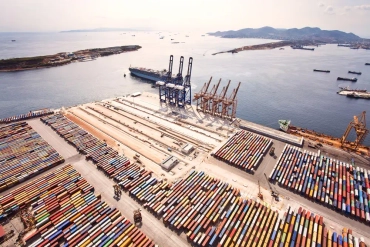
Top 10 ports in China



Top 10 ports in China
As an economic powerhouse, China’s financial influence and prowess must not be overlooked and underestimated. China is the world’s top exporter, far leading second-placed US by nearly 50%. That said, it should then come as no surprise that seven of the top 10 largest ports in the world are located in China.
Coupled with the fact that shipping is responsible for 90% of world trade, it’s safe to say that China is a major influencer of the world’s commercial trade ocean freight movements. If you’re looking to do business with China, besides knowing how to negotiate with them, it’s probably also advisable to read up on the entry and exit points for goods and merchandise.
Here’s a breakdown of the top 10 ports in China.
1. Port of Shanghai
With a new world record of 40 million TEUs handled in 2017, the Port of Shanghai has probably now cemented its spot as not only the busiest port in China, but also that of the world. In comparison, second-placed Singapore managed 33.7 million TEUs.
As a gateway port for the Yangtze River Delta, Shanghai Port’s developments in recent years have been astounding. It crossed the 30 million TEUs mark barely six years ago in 2011. It’s staggering to think that when the port first started operations 40 years ago, it had a handling capacity of less than 8,000 TEUs.
Today, it’s also home to the world’s largest automated container terminal, the Yangshan Deep Water Port. And not too long ago, it began trial operations which include automated handling equipment and management system.
“Handling a whopping daily average well in excess of 100,000 teu, the Chinese port is thus expected to have handled a total volume of some 40.2 million teu in the calendar year 2017, a year-on-year growth of 8.3%.”
- Alphaliner
It’s located close to many factories located in neighboring provinces of Zhejiang and Jiangsu. And given China’s role as the world’s largest exporter, its strategic location makes it one of the most important ports for foreign trade.
2. Port of Shenzhen
Located in Guangdong Province, the Port of Shenzhen connects China’s southern hinterland to pretty much the rest of the world. Known as the gateway to the Pearl River Delta and Hong Kong, the port managed 23.98 million TEUs in 2016.
The port consists of an eastern and a western port. But overall, it’s spread out over some 260km of the city’s coastline. Around 560 ships call at Shenzhen Port monthly, covering over 130 international container routes.
Its special economic zone has lured companies from far abroad, including Wal-Mart, which has its Asian headquarters there. But it’s probably more known for its ‘high-tech’ surroundings, with thousands of electronics manufacturers having set up there. It’s estimated that over 25 million people now work in the electronics sector in Shenzhen.
3. Port of Ningbo-Zhoushan
Shanghai may be the first to cross the 40 million TEU mark, but it’s the Port of Ningbo-Zhoushan that holds the crown for being the first port to handle 1 billion tonnes in cargo throughput in a calendar year. That’s largely thanks to the huge crude oil terminal and ore loading berth. It’s also home to a domestic liquid chemical storage space.
The result of a merger between Ningbo and Zhoushan ports in 2006, the port is located in China’s Zhejiang Province. Just like Shanghai, it has also seen great advancements in recent years both locally and globally. Already, it was offering regular intermodal rail services to the hinterlands. But it has recently launched new services, with its sea-rail transport lines now providing 11 train services to 36 cities in China and reaching farther out countries in central and northern Asia, and even eastern Europe.
It lies at the crossroads of the Silk Road Economic Belt and the 21st Century Maritime Silk Road, making it one of the busiest ports in China. Additionally, its 242 sea routes link to over 600 harbors across the globe.
4. Port of Hong Kong
Formally the world’s top port, Hong Kong has fallen in ranks since it was knocked off its throne in 2004. It continues to slip, as it reports weaker traffic in 2017. Analysts say Hong Kong may lose its place in the top 5 ports in the world should cargo handling trends persist.
The Port of Hong Kong once served as a cargo conduit for cargo entering and leaving China. But ever since Chinese authorities decided to boost its services at mainland ports such as Shenzhen and Shanghai, there was more incentive to head directly to the mainland and lost was the need to dock at Hong Kong.
“There’s a general trend of increased direct services to China, so there’s reduced demand for transshipment in Hong Kong.”
- Victor Wai, Drewry Analyst
Despite that, it continues to be one of the busiest ports, managing over 20 million TEUs in 2016. The natural shelter and deepwater facilities at the harbor makes for good berthing conditions and the handling of many different types of vessels.
5. Port of Guangzhou
This South China port is located at the mouth of Guangdong Province’s Pearl River near Hong Kong and Macau and is largely considered to be the main port in the Pearl River Delta region. It handles mainly manufactured, industrial, and agricultural goods. In 2016, it managed 17.59 million TEUs.
Given its location, cargo going in and out of nearby provinces such as Yunnan, Sichuan, Jiangxi, Guizhou, and Guangxi also go through the Port of Guangzhou. It sits at the confluence of the Dongjiang, Xijiang, and Beijiang rivers, all of which are equipped with waterway, expressway, railway, and air services.
Once a trading port, it served as one of China’s busiest ports during the Ming and Qing dynasties. Today, thanks to its strategically-placed location, it has sea connections to over 300 ports in more than 80 countries all over the world.
6. Port of Qingdao
The Port of Qingdao is famous as an international transshipment and reefer specialty port. It’s located in the Yellow River basin in eastern China’s Shandong Province. In 2016, it handled 17.44 million TEUs.
It is equipped with a large terminal apt for handling iron ore with plans to develop it into the world’s largest iron ore handling terminal. It ranks sixth in the world in metal ore throughput and has shipping routes that links over 700 ports around the world.
In 2011, the Port of Qingdao entered into a strategic alliance with three other Shandong ports and South Korea’s Busan Port with the objective of building a logistics and shipping center in Northeast Asia.
7. Port of Tianjin
This is the largest port in northern China, serving 11 northern provinces as well as Mongolia. It’s formerly known as the Port of Tangu and is the main maritime gateway to Beijing. Currently, it covers 100 square kilometers, making it the largest man-made seaport in China and also one of the most connected ports, serving as a link between Northeast Asia and Central and West Asia.
Tianjin Port was one of the earliest Chinese foreign trading ports, with roots traced back all the way to the Han Dynasty. Today, it connects with over 300 ports and 160 regions in the world.
In August 2015, over 170 people were killed at one of its container storage stations following a series of explosions caused by the illegal storage of 11,300 tonnes of hazardous chemicals.
8. Port of Dalian
Located at the mouth of Bohai Bay, the Port of Dalian is a deep water port in China’s northeastern Liaoning Province and the biggest port in northeastern China. It’s status as the second-largest container transshipment hub in mainland China boosts its trade movements to and from the Pacific.
Besides connecting to ports in over 160 countries, it also serves seaports located in northern and eastern Asia, and the Pacific Rim. It’s the most northern ice-free port in China and in terms of size, one of the five-biggest in the country.
Unlike the Port of Tianjin, which is becoming increasingly international, the Port of Dalian remains heavily dependent on traditional heavy industries such as coal. But analysts have tagged Dalian for growth following the establishment of the Free Trade Zone in Liaoning.
9. Port of Xiamen
The Port of Xiamen is located on the Jiulongjiang River estuary in Fujian Province. Given its position as the closest mainland port to neighboring Taiwan, it was the first mainland port to begin shipping cargo directly to Taiwan’s Kaohsiung Port. It continues to handle a lot of cross-strait trade even till today.
Stretching for around 30 kilometers along the coast, the port itself is spread out over 12 different areas and as both river and deep-water facilities. That said, it services over 65 shipping routes and connects with over 50 countries all across the world. On average, it handles 469 ship calls per month.
10. Port of Yingkou
This northeastern Chinese port handled 5.92 million TEUs in 2016 and continues to grow. As the second-largest port in the northeastern region after Dalian, it’s a major import facility also for certain parts of Mongolia. Its main cargo types include grain, sugar, minerals, coal, steel, and vehicle imports.
The history of Yingkou Port goes back nearly a millennium, with largely river and coastal trades. But international maritime shipping activities only really began in 1858. Over the past two decades, many investments have been made to develop the port, including the construction of a container terminal at Bayuquan Port. In 2015, Yingkou Port entered into the list of top 50 container ports in the world.
And more recently in 2016, the port signed a strategic partnership with Russian Railways to build a jointly operated international terminal and logistics center in Russia.
Related Articles


